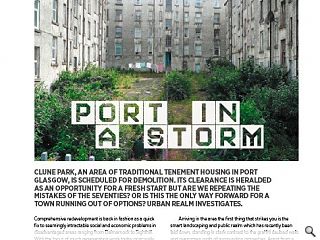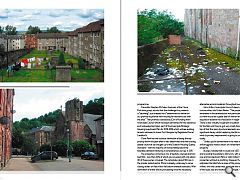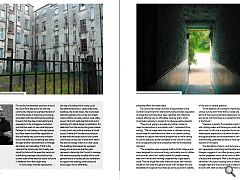Port Glasgow
30 Oct 2012
Clune Park, an area of traditional tenement housing in Port Glasgow, is scheduled for demolition. Its clearance is heralded as an opportunity for a fresh start but are we repeating the mistakes of the seventies? Or is this the only way forward for a town running out of options? Urban Realm investigates.
Comprehensive redevelopment is back in fashion as a quick fix to seemingly intractable social and economic problems in disadvantaged areas ranging from Dalmarnock to Sighthill. With the focus of much regeneration work today principally centred on the mistakes of the 1970s, with giant post war tower blocks bearing the brunt of changed attitudes and fortunes, one redevelopment project stands apart - Port Glasgow’s Clune Park, which is composed predominantly of pre-war tenements.Port Glasgow with its chronic problems of substandard housing and declining population, common to the entire Inverclyde region, is at the forefront of a new mood toward de-densification and contraction. The Clune Park area being a case in point, forming part of a regeneration strategy for the area that will entail demolition of 430 properties over the next five years, with just 16 additional new homes built to replace them.
Arriving in the area the first thing that strikes you is the smart landscaping and public realm which has recently been laid down, standing in stark contrast to the graffiti daubed walls and overgrown roofs of surrounding properties. Apart from a few residents wandering around the estate looks to have been abandoned to its fate with boarded up windows proliferating over their glazed neighbours. Yet behind the grime this is a solidly built, urban locale whose red sandstone facades are unlikely to be bettered by any new build.
A comprehensive regeneration plan has been drawn up for the ailing district to tackle the social and physical problems which exist there. This will entail the rehousing of remaining tenants and a scorched earth process of demolition that will include not just those properties that fall below the tolerable standard but those that are above the standard as well after they are acquired for incorporation into the general demolition programme.
Councillor Stephen McCabe, chairman of the Clune Park task group, admits that the challenge this presents is “daunting”, but stresses he is “determined to deliver on our promise to provide new housing for residents out with the area.” That promise is backed by £2m of funding from Inverclyde Council which has been earmarked for the clearance and redevelopment plan, part of the Inverclyde Strategic Housing Investment Plan for 2012-2015 which will see existing tenants rehoused in lower Port Glasgow by Registered Social Landlord’s.
Clune Park has the dubious distinction of being the top priority within this plan after it was determined that the existing estate could not be brought up to the Scottish Housing Quality Standard – with the majority of homes falling below the tolerable standard following a comprehensive survey in 2011.
The properties comprise a mix of bedsits, one bed and two bed flats - less than 30% of which are occupied with only about 30 of these owner occupied. The remainder, about 150, are in the private rented sector. Work is already underway to serve closing orders on flats which fall below tolerable standard. With demolition of entire blocks proceeding once the necessary orders are in place and existing tenants are rehoused in alternative accommodation throughout lower Port Glasgow.
John Arthur, Inverclyde Council’s head of safer communities, told Urban Realm: “The properties were renovated in the seventies but not particularly sympathetically, so there would be a great deal of interior reorganisation required in addition to a reduction in height of some properties. There is also virtually no general circulation space available for the flats and they’ve got very small shared backcourts. On top of that the main structural elements are showing signs of significant decay, whilst replacing the flat roofs with pitched roofs (a primary requirement) is going to prove exceptionally costly.
“Unless you’re somewhere in the west end of Glasgow you will struggle to make a return on investment on that kind of property.”
Studies indicate that it would cost c£33 million to refurbish and re-profile the estate to 360 units, with a 40/60 split of one and two bedroom flats or c£24 million to refurbish the properties without re-profiling. However the district valuer estimates the total future value of the properties to be c£18.5 million, with the caveat that, given the low demand for housing of this type, size and location in Inverclyde, releasing this quantity of property onto the market at the same time could adversely affect the resale value.
The council has made a number of approaches to the Scottish Government for additional funding to allow acquisition of properties but these have been rebuffed with Holyrood instead offering only an affordable housing grant, which Inverclyde is already in receipt of, to rehouse existing tenants.
“They’re not going to provide any further money to meet the demolition or acquisition costs”, concedes Arthur, adding: “We no longer have the power to declare housing action areas for demolition and there is no central funding available to support that kind of programme so we’re having to use the statutory powers available to the council to close and subsequently demolish properties that fail the tolerable standard.
“The properties were originally built by Scott Lithgow and were designed for communal living, particularly around utilities and services, which isn’t really suitable for people owning their own homes and working cooperatively to get repairs done. They’ve all got flat roofs, there are issues with thermal insulation and there are general issues with disrepair and sub tolerability throughout the whole site so the economic viability of the site is in severe question.
“In the absence of funding for improving works to be carried out we don’t think that’s a viable site. It’s not viable in terms of the housing demand assessment carried out recently and we do not think there is a market for that size of property in the future.”
There are currently 75 properties which have been served with closing orders and three upon which demolition orders are in train. A soft strip is expected to be carried out when these expire, expected to be within the next few months, until enough properties can be assembled to carry out demolition economically, potentially as early as next year and phased over a period of five years.
The demolition of slums, and slums are what these are, isn’t necessarily a bad thing but the bitter experience of nearby Glasgow suggests it can often go awry, particularly when historic properties which do so much to define the character of a place are destroyed. With a declining population some demolition of surplus housing stock is inevitable but with budgets tight and resources scant it surely makes more sense to work with what we have than start from scratch.
----------------------
For me the fundamental questions around the Clune Park area are to do with the community interest (or perhaps the lack of it) and the waste of resources and energy associated with demolishing the buildings. It seems that the idea of demolishing the area seems to be a foregone conclusion and that few seem to care what happens. Perhaps I’m not looking in the right places but there seems to be little opposition to this and hardly any community ambition to turn the area into something else, either through another refurbishment or through demolition and rebuilding. If that is the case and the community don’t really care about the future of the area that sends out a disturbing message not just about the current state of the area but about its future in whatever form that might take.
In some ways, the area represent an old way of building which many could feel sentimental about - good solid stone buildings, the social closes, the overlooked safe back gardens, the cul-de-sac streets where children can play without road safety issues. Yet it isn’t really like that at all and it certainly isn’t about design or aesthetics. It is detached from the surrounding area, beside a noisy trunk road with all manner of social issues. If there isn’t the desire or pressure to deal with the issues around the current community or any sort of drive from within the area to change it then it is a lost cause. The buildings themselves do represent energy and a resource but they also represent a failure by the Council to manage this resource properly coupled with a more general failure of society and its institutions to support the existing community and encourage it to act differently.
Willie Miller, WMUD
|
|
Read next: Autumn manifesto
Read previous: The Golden Section
Back to October 2012
Browse Features Archive
Search
News
For more news from the industry visit our News section.
Features & Reports
For more information from the industry visit our Features & Reports section.





